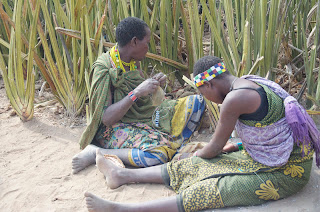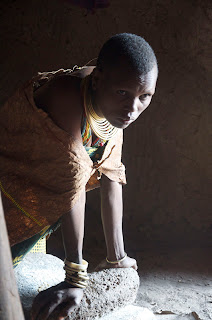 |
| here we are leaving our car behind and walking into the bush looking for the bushmen's camp site |
 |
| We found the bushmen and were greeted with this lovely view. Baboon skulls |
 |
| The bushmen gathering around their morning fire. We were told they were planning their hunting strategy |
 |
| The women of the camp were sitting around a different camp fire as is the custom of the tribe |
 |
| Dik Dik meat hanging from the trees to dry |
 |
| dead Dik Dik waiting to be skinned and the meat dried |
 |
| bushmen wearing Baboon skin. We were told that normally they wear loin cloths but the Tanzanian government insisted that they wear shorts or trousers, and it was law. |
 |
| A Baobab tree. We were told the bush women gather the fruit and make a sweet paste from it. |
 |
| Inside of the Baobab fruit. The white pieces are what are eaten. I tried it and it is a taste you need to grow up on I think |
 |
| After watching our guide break into the Baobab fruit Little Man gave it a try. Neither child would try tasting the fruit inside but loved opening the fruit. |
 |
| the bushmen could walk/run very fast so it wasn't long before we lost sight of them |
 |
| Here our guides are whistling trying to locate the bushmen (who are probably laughing about the slowness of the white people) eventually the bushmen whistle back and we were on our way again. |
 |
| Taking a break while waiting to see what direction the bushmen went. |
 |
| The first kill which we missed as we were too far behind. This is a small bird |
 |
| then things got a little exciting as the hunters spotted a squirrel in the trees. |
 |
| We watched as they planned their attack and tried to catch the squirrel |
 |
| This particular squirrel was feisty and in addition to using their arrows they threw branches into the tree trying to flush the squirrel into sight |
 |
| Here a bushmen is climbing a tree and cutting branches to make more arrows |
 |
| Success at last! I kinda felt sorry for the squirrel |
 |
| Little man wanting to have a closer look. I was surprised my kids weren't more upset over the dead animals but both were very matter of fact about the need to kill in order to eat |
 |
| The bushmen starting a fire using wood from the Sandpaper tree. The leaves of this tree really feel like fine sand paper |
 |
| Blowing on the spark |
 |
| Putting the catch of the day on the fire. While the bird was striped of its feather the fur of the squirrel was left on and then scrap off after cooking |
 |
| Eating breakfast. We were not asked to join in, thankfully |
 |
| Returning to camp we saw two Dik Diks (which are very small antelopes) hanging from the tree |
 |
| Observing the women making beaded necklaces |
 |
| Next we were given the opportunity to try out their arrows. |
 |
| I hit the target and surprised the bushmen who loudly clapped. I have shot a bow before:) I don't think they expected a women to know how to shot a bow let alone hit the target! |
 |
| Our driver having a turn at the bow. |
 |
| One of the children of the camp with a Baobab fruit beside them. |
 |
| Animal skins nailed to the tree |
 | |
| Baobab shells decorated with beads |
 |
| One of the shelters made by the bushmen |
 |
| Another room made in the bush, we were told the Hadzabe move location whenever game is scarce to find |
 |
| pots for cooking and a shelf made of Oldupai (also known as Sisal) branches |
 |
| another make shift shelf |
 |
| Storage of newly made arrows. We were told the bushmen also use poisen arrows to bring down some of the bigger game they hunt. |
















